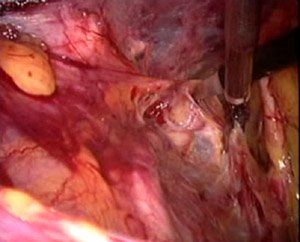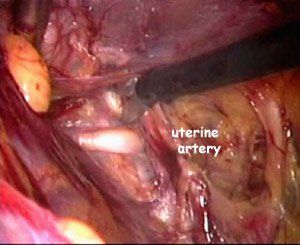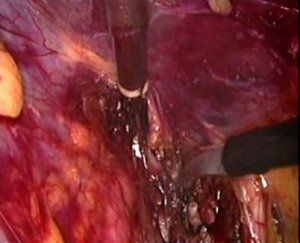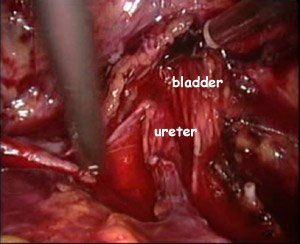Unroofing of the Ureter for Radical Hysterectomy
Unroofing the ureter in the cardinal ligament is the most important step during radical hysterectomy. At our institution we developed a modified laparoscopic technique to free the ureter from its roof through the cardinal ligament. The technique is based on the advantages of laparoscopic surgery which mainly are: more accurate haemostasis, magnification of the anatomical structures and positioning of the scope parallel to the ureteral course instead of perpendicular like in open surgery.
Article Information: Publication Date: 04/08/2003
Practical Tip
Unroofing the ureter in the cardinal ligament is the most important step during radical hysterectomy. At our institution we developed a modified laparoscopic technique to free the ureter from its roof through the cardinal ligament. The technique is based on the advantages of laparoscopic surgery which mainly are: more accurate haemostasis, magnification of the anatomical structures and positioning of the scope parallel to the ureteral course instead of perpendicular like in open surgery. Even if many authors have reported about techniques for carry out radical laparoscopic hysterectomy, this method for unroofing the ureter has not been previously described.
We start hysterectomy dissecting the ureter up

to the crossing with the uterine artery in the broad ligament.
When the artery is visible and isolated , it is coagulated at its origin from the hypogastric artery. Then the anterior parametrium is entered by blunt dissection working on the ureter. The uterine artery is not severed but kept in place and used as a guide to the ureteral tunnel. Blunt dissection is continued as far as possible in the anterior parametrium and only at this moment the uterine artery is cut as well as the tissue surrounding the ureter. This technique allows isolation of the ureter before starting the dissection of the bladder on the plane of the vesico-vaginal septum, since it is performed from the posterior aspect of the parametrium.
According with our modification, the first step of the radical hysterectomy

is opening the broad ligament to the level of where the uterine artery crosses the ureter which lies underneath. The clip shows the relationship between the ureter and the uterine artery. The ureter is freed from the uterine artery, which at this point is coagulated. Coagulation of the uterine artery reduces the bleeding from the parametrium.
(Download QuickTime here to view the videos.)
As second step, it is easier to unroof the ureter following its course into the anterior parametrium, working directly on its adventitial sheath along its lateral and superior aspect. The uterine artery is left in place and not cut since it is easier to enter the space below the vessel when it is intact. We generally dissect the ureter as far as possible by blunt dissection.

Progressively the ureter is totally freed. Sometimes it is possible to isolate and directly coagulate the deep uterine vein as shown in the video clip.

Only after the ureter has been freed along its lateral side, the uterine artery is cautiously severed.

The picture and video clip show the dissection of the ureter from the anterior parametrium. The ureter is followed almost to the bladder.


Final result of dissection. The ureter enters the bladder.

References:
Reprinted with kind permission from TheTrocar.com
References
Kenter GG, Heintz AP. Surgical treatment of low stage cervical carcinoma: back to the old days? Int J Gynecol Cancer 2002;12:429-434. (Medline)
Lee CL, Huang KG, Jain S, Lee PS, Soong YK. Comparison of laparoscopic and conventional surgery in the treatment of early cervical cancer. J Am Assoc Gynecol Laparosc. 2002;9:481-487. (Medline)
Lee CL, Huang KG. Total laparoscopic radical hysterectomy using Lee-Huang portal and McCartney transvaginal tube.J Am Assoc Gynecol Laparosc. 2002;9:536-540. (Medline)
Lee YS, Lee TH, Koo TB, Cho YL, Park I. Laparoscopic radical parametrectomy including paraaortic and pelvic lymphadenectomy in women after prior hysterectomy: three cases. J Laparoendosc Adv Surg Tech A. 2003;13:123-126. (Medline)
Lin YS. Preliminary results of laparoscopic modified radical hysterectomy in early invasive cervical cancer. J Am Assoc Gynecol Laparosc. 2003;10: 80-84. (Medline)
Spirtos NM, Eisenkop SM, Schlaerth JB, Ballon SC. Laparoscopic radical hysterectomy (type III) with aortic and pelvic lymphadenectomy in patients with stage I cervical cancer: surgical morbidity and intermediate follow-up. Am J Obstet Gynecol 2002;187:340-348. (Medline)

